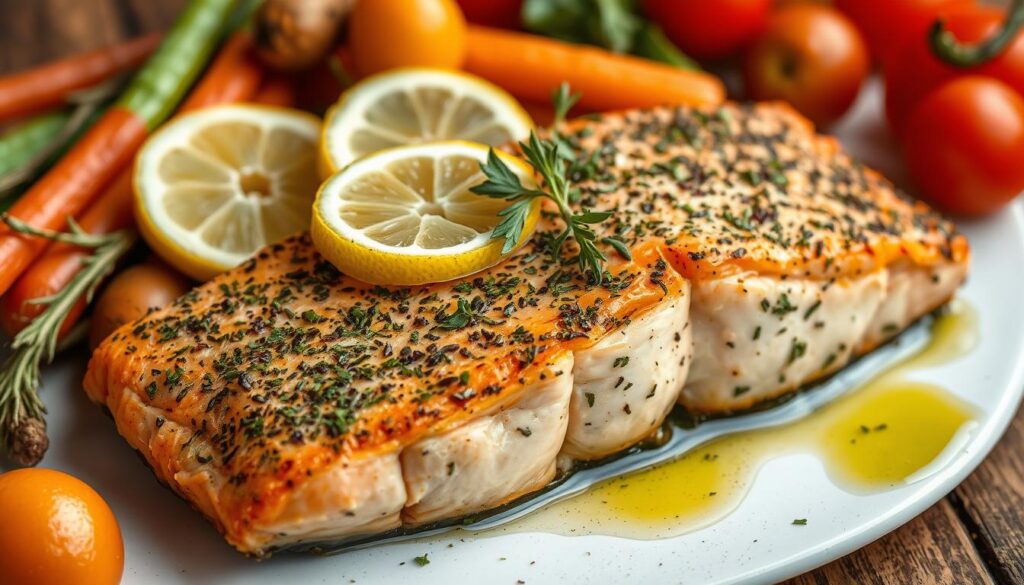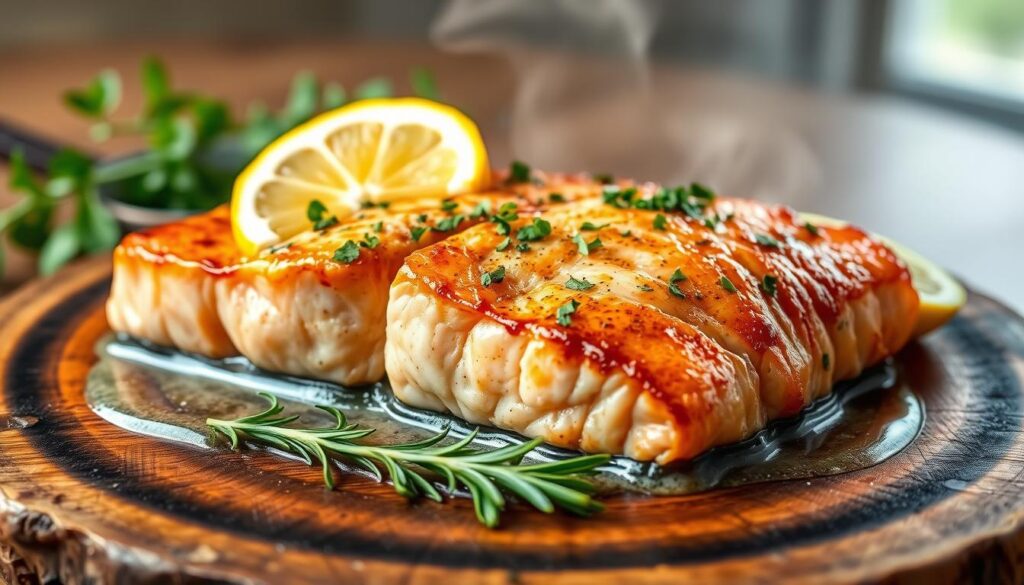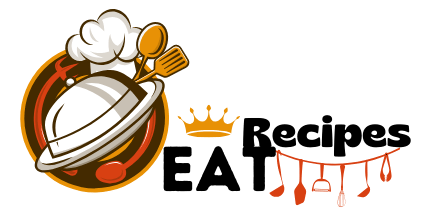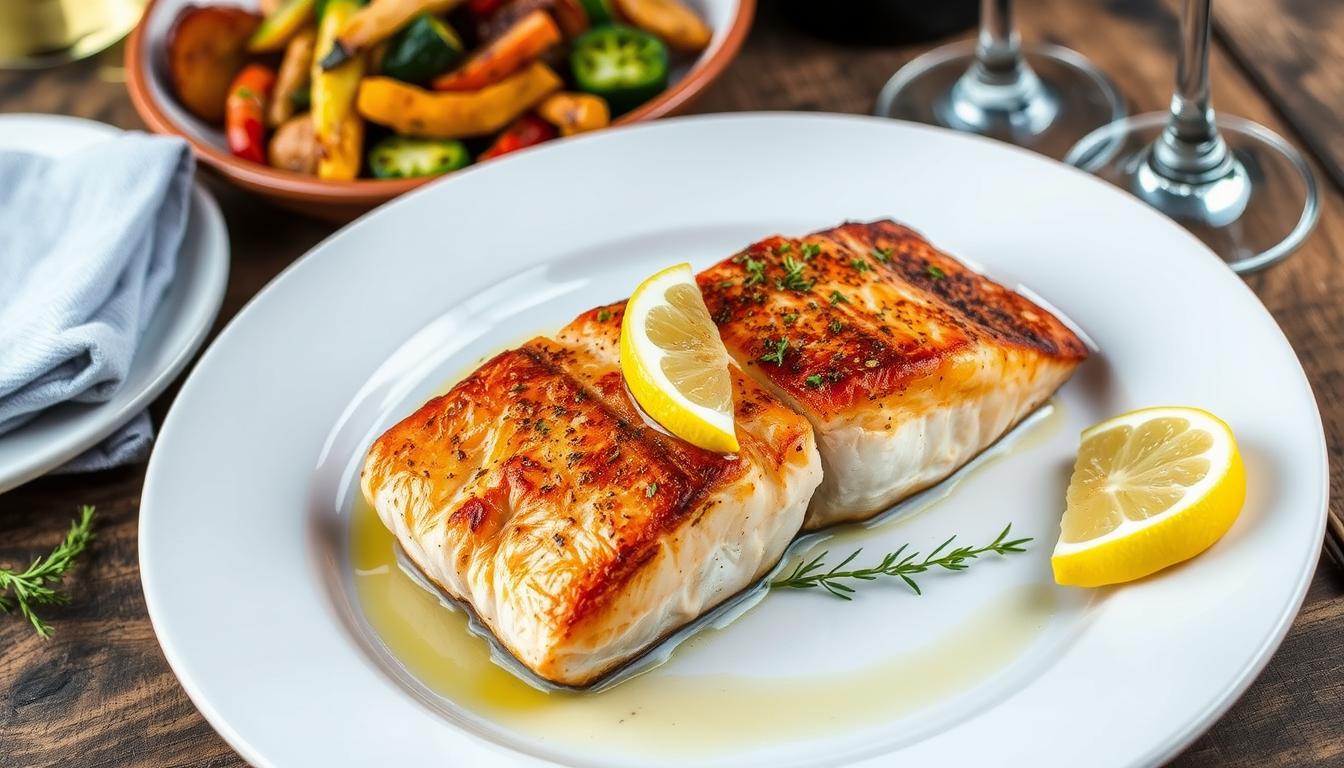How To Cook Salmon Steak – Eat Recipe
As the sun sets, the day’s hustle and bustle slow down. The smell of sizzling butter and the fish’s gentle sear bring comfort. It’s a reminder that even busy weeknights can be special. This salmon steak recipe is perfect for both seasoned chefs and kitchen novices.
Table of Contents
Key Takeaways
- Salmon steaks are an ideal choice for a quick and flavorful seafood dish.
- This recipe showcases the versatility of salmon, with a total cooking time of just 15 minutes.
- The recipe has garnered a high rating of 4.96 out of 5, indicating its popularity among readers.
- Detailed nutritional information is provided, making it easy to monitor your dietary intake.
- The recipe author, Vered DeLeeuw, is known for her engaging newsletters and diverse salmon recipes.
Understanding Salmon Steaks vs Fillets
When cooking fresh salmon fillets, you can choose between steaks or fillets. Both come from wild caught salmon, but they differ in key ways. This affects your choice for the best cut in your recipe.
Key Differences in Cuts
A salmon steak is cut crosswise, including the bone. Fillets, on the other hand, are cut lengthwise, away from the bone. Steaks have skin, while fillets are often skinless. This makes steaks more even and rectangular, unlike the long, thin fillets.
Anatomy of a Salmon Steak
A salmon steak has a central bone and belly flaps that look like little legs. This unique shape adds to the steak’s appeal and makes it enjoyable to eat.
Benefits of Choosing Steaks
Salmon steaks have several benefits over fillets. Their even shape makes them easy to portion and cook evenly. The bone helps keep moisture and flavor in during cooking. Plus, steaks look impressive on the plate.
Both salmon nutrition-rich steaks and delicate fillets open up many cooking possibilities. Knowing the differences helps you pick the right cut for your needs and taste.
Essential Ingredients and Kitchen Tools
To make a tasty salmon steak dish, you’ll need some key ingredients and tools. First, get high-quality omega-3 rich foods like fresh salmon steaks. You’ll also need sea salt, black pepper, and herbs like dried sage or Italian seasoning.
For cooking, a large non-stick or cast-iron skillet is crucial. A sharp knife is useful for deboning the fish. Butcher’s twine can help tie the steaks, if you like. An instant-read thermometer ensures the salmon is cooked just right. If grilling sustainable seafood, you’ll need a well-oiled grill and possibly a chimney starter.
For a fresh touch, have lime or lemon juice ready to drizzle over the salmon. With these ingredients and tools, you’re set to make a delicious and healthy salmon steak dish.
| Ingredient | Quantity |
|---|---|
| Salmon Steaks | 4 steaks |
| Olive Oil | 1 tbsp |
| Sea Salt | 1/2 tsp |
| Black Pepper | 1/2 tsp |
| Garlic, minced | 2 cloves |
| Onion Powder | 1 tsp |
| Chili Powder | 1 tsp |
The recipe also needs a compound butter. It’s made with 3 tablespoons of salted butter, 2 garlic cloves, and 2 tablespoons of fresh herbs like chives and parsley.
Preparing Your Salmon Steak for Cooking
Before you can enjoy a perfectly cooked salmon steak, some prep is needed. You’ll need to debone, roll and tie, and brine the salmon. Let’s explore each step to make sure your salmon steak is perfect.
Deboning Technique
Deboning a salmon steak is a key step. Use a sharp knife to remove the meat from the spine. This makes sure your bite is smooth and the texture is great.
Rolling and Tying Method
To cook evenly, roll and tie the salmon. Fold the belly flaps and curl the steak into a round. Use twine to hold it in shape. For thin steaks, a bamboo skewer helps too.
Brining Tips
Brining the salmon in salt water for 10-15 minutes boosts flavor. It also cleanses the fish and makes it firmer. This leads to a more tender and tasty dish.
With these prep steps, you’re ready to cook a salmon steak that will wow everyone.
Perfect Seasoning Combinations
Enhancing the taste of your salmon steak is simple with the right seasonings. You can choose from classic or adventurous options. Each one brings out the best in this healthy fish dish.
Try a mix of salt, pepper, and dried sage for a tasty choice. Sage’s earthy taste goes well with salmon’s richness. Or, use an Italian seasoning mix for a Mediterranean flavor.
For a zesty twist, squeeze lemon or lime juice on the salmon after cooking. This adds a refreshing contrast to the fish’s natural oils.
For an Asian flair, try a homemade teriyaki sauce as a glaze. It combines soy sauce, rice vinegar, and sweetness, enhancing the salmon’s taste.
The goal is to boost the salmon’s flavor without overwhelming it. Try different spice blends to find your favorite.
| Seasoning Combination | Ingredients | Suggested Cooking Method |
|---|---|---|
| Classic Herb | Salt, pepper, dried sage | Grill or pan-sear |
| Mediterranean | Italian seasoning (thyme, rosemary, oregano) | Oven-roast |
| Citrus Burst | Fresh lemon or lime juice | Grill or pan-sear |
| Asian-Inspired | Homemade teriyaki sauce | Grill or broil |
The best seasoning for your seafood and fish dishes is one that complements the salmon. It should match your taste preferences too.

Grilling Salmon Steak to Perfection
Grilling grilled salmon is a true art. It’s about finding the perfect mix of tenderness and flavor. Whether you’re experienced or new, learning to grill salmon steaks can make your meals better. This omega-3 rich seafood adds a delightful taste.
Temperature Control
Getting the temperature right is crucial for grilling salmon steaks. Heat your grill to 450°F to 500°F. Clean and oil the grates to avoid sticking. This high heat will give the salmon a tasty crust.
Timing Guidelines
Grill the salmon steaks for 6-8 minutes on the skin side. Then, flip them and cook for 2-4 minutes on the other side. This ensures the salmon is cooked just right, with an internal temperature of 125°F to 130°F. Let it rest for 5 minutes before serving to keep the juices in.
Glazing Techniques
Adding a glaze can enhance the flavor of your grilled salmon. Brush the glaze on after flipping the salmon, and again before taking it off the grill. This gives your dish a shiny, flavorful finish.
Mastering temperature, timing, and glazing can make your grilled salmon steaks perfect. You’ll enjoy the delicate texture and rich flavors of this nutritious seafood.
“Grilling salmon is like a well-choreographed dance, where temperature, timing, and technique come together to create a masterpiece on the plate.”
Pan-Seared Salmon Steak Method
Try this quick and easy pan-searing method for a delicious salmon steak. It’s perfect for a healthy meal or to add flavor to your dishes. This technique ensures a tasty, golden-brown crust on your salmon steak.
Start by seasoning your salmon steak with your favorite spices and herbs. This adds a rich flavor to every bite. Next, melt butter in a large skillet over medium-high heat. Once the butter stops foaming, add your seasoned salmon steak to the pan.
Cook the salmon for about 3 minutes on the first side. Then, flip it and cook for another 3 minutes on medium heat. It’s done when it turns opaque and reaches 145°F. Spoon the pan juices over the salmon before serving for extra flavor.
| Prep Time | Cook Time | Total Time | Servings |
|---|---|---|---|
| 15 minutes | 10 minutes | 25 minutes | 2 servings |
This salmon steak recipe is a tasty and healthy option for any meal. Serve it with roasted veggies or a fresh salad for a complete meal.

For perfectly pan-seared salmon steak, don’t move the fish too much. This helps the crust form and keeps the fish moist. Enjoy the rich, buttery taste of this healthy fish dish!
Serving Suggestions and Side Dishes
Salmon steak is a versatile protein that pairs well with many side dishes. You can find healthy seafood recipes or create a balanced meal. Options range from fresh vegetable medleys to comforting starch-based sides. These dishes will make your salmon steak meal better.
Complementary Vegetables
Pair your salmon steak with expertly prepared vegetables to enhance its flavor. Some great choices include:
- Roasted broccolini with garlic and lemon
- Creamy mashed cauliflower
- Refreshing coleslaw with a tangy dressing
- Crisp cucumber salad with dill and vinegar
- Juicy tomato salad with balsamic and basil
- Peppery arugula salad with citrus vinaigrette
Sauce Pairings
Choose flavorful sauces to complement the rich taste of your salmon steak. Some excellent options are:
- Classic lemon butter sauce for a bright, citrusy finish
- Light and herbal dill sauce for a touch of freshness
- Teriyaki glaze for an Asian-inspired twist
Top your salmon steak with thinly sliced scallions and serve with lemon wedges. This adds a burst of vibrant flavor.
| Side Dish | Total Time | Difficulty | Main Ingredients |
|---|---|---|---|
| Roasted Broccolini with Garlic and Lemon | 20 minutes | Beginner | Broccolini, olive oil, garlic, lemon juice |
| Creamy Mashed Cauliflower | 25 minutes | Intermediate | Cauliflower, butter, heavy cream, garlic, salt, pepper |
| Refreshing Coleslaw with Tangy Dressing | 15 minutes | Beginner | Cabbage, carrots, mayonnaise, vinegar, sugar, salt, pepper |
Storage and Leftover Tips
Leftover salmon steak is great for busy weeknights. It’s full of salmon nutrition like Omega-3 fatty acids and protein. It also has important vitamins and minerals. To keep your sustainable seafood fresh and safe, store and reheat it right.
Let the salmon cool down before putting it in an airtight container. Then, refrigerate it. You can keep leftover salmon in the fridge for 3-4 days. To reheat, use the stovetop or oven carefully. Or, try microwaving at 50% power, covered.
You can also eat leftover salmon cold. Try it in a salad or on a grain bowl. Or, use it in salmon cakes or spread. Always check the salmon before eating it. If it smells bad or looks off, throw it away.

